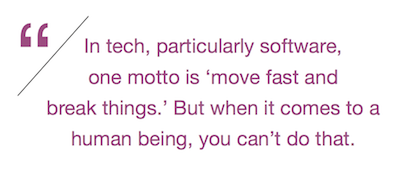Future Now
The IFTF Blog
At The Nexus Of Science Fiction and Future Fact with Ramez Naam
The single most important law of futures studies is that there are no facts about the future. Only fictions. Ramez Naam lives by that law, having written the award-winning Nexus series of science fiction novels that provoke readers with thrilling tales of digital telepathy, brain-hacking, biotechnology, and civil liberties in the networked age. Ramez’s visionary fiction is rooted in science fact. For 13 years, he was a computer scientist and technologist at Microsoft, where he helped lead the development of tools like Outlook, Internet Explorer, and Bing. Ramez is also the author of two future-focused works of non-fiction, More Than Human: Embracing the Promise of Biological Enhancement and The Infinite Resource: The Power of Ideas on a Finite Planet. We spoke with Ramez about the promise and peril of wearable computing.

In the last few years, the first wearables have become mainstream in forms like the Fitbit and Apple Watch. As someone who has been involved in building digital technology for decades, and also imagining its future as a science fiction writer, what is surprising you most about the way this is playing out?
I’m surprised how much value people are getting out of a very limited amount of data. In science fiction, wearables or implants tend towards the more sophisticated—tracking your metabolism, your levels of nutrients, your blood chemistry, etc... or are able to manipulate those. But we’re seeing millions of people wearing devices that measure little more than their number of steps taken.
To me that speaks of the incredible power of feedback on our behavior. Even a limited, very indirect variable like how many steps you’re taking is enough to motivate people to do more. So why wouldn’t people adopt something simple that gives them this one piece of data?
What scares you the most about wearables?
The scariest thing in wearables is security. Everything on the planet can be hacked. We have to accept that in this day and age. Humans have yet to build a truly secure system. We can make things more secure, in the sense that it takes more effort or time or money to attack them, or that there’s less valuable data for them to give up. But we’ll never hit 100% security on anything. So now we have this explosion of devices— between the Internet of Things and the explosion of wearables (which we might think of as part of the IoT). And that means that we’re increasing the attack surface, increasing the number of potential ways to hack into someone's data.

When wearables were only Fitbits and fairly limited in their functionality, that might have not been such a big deal. But now, with the Apple Watch and that class of devices, you have another device on your person that has access to your email, your texts, possibly your files, a GPS that tracks your location, and so on. That’s one more way to potentially get that information of yours. And as we start talking about the rest of the Internet of Things—when cars, homes, thermostats, appliances, power outlets, light bulbs, and everything else are online—that attack surface just keeps growing. Will all of those vendors do rigorous security testing? Will they all update their software frequently enough when bugs are found? Because there are always security bugs found.
Does that mean we should give up on wearables or connected devices? No. They still offer huge value. But I think we need to find ways to push for higher levels of security, higher levels of ongoing vigilance, and better defense and policing against crimes.
What is the technology’s potential that makes these risks worthwhile?
I’m excited by the prospect of more intimate data input and output for these devices. Looking down at a smart watch is a little more convenient than looking at a phone. But the user interface is limited on such a tiny screen. I’m looking forward to devices that can display information right into my visual field, and to devices that can accept gestures and glances as input. Google Glass was a flop of a product. It just wasn't there yet in terms of utility or convenience. But I think we'll see more happening in this direction each year. HoloLens looks truly impressive. It’s still too big and bulky. But Moore’s Law being what it is, we’ll see the electronics get smaller and cheaper, the power requirements drop, and the devices get more sophisticated.
I also think we’ll see more narrow and task-specific use of this technology. I’m excited by things like the Daqri Smart Helmet, which is an augmented reality helmet for industrial uses. You’d never wear this thing in your day-to-day life (unless, maybe, you’re Daft Punk), but for some jobs, you can see that there’s a lot of value. And similar things may happen for motorcycle riders—there are at least half a dozen smart motorcycle helmets in development that can add things like mapping or proximity sensors and collision avoidance to the riding experience. Basically, it’s still incredibly early days. We’re at the Apple II level of wearables now.
Ten years ago, you wrote “More Than Human,” about the future of technologies to enhance the body and mind. Has research in this space moved faster or slower than you expected?
Mostly research on human enhancement has moved more slowly than I expected. There are two reasons for that. First, while biology really is code, it’s spaghetti code. The genome is a lot like software. But it’s crazily messy, interwoven software, where you can’t change one variable without affecting a dozen others. So there are fairly few things we can tweak inside the human body or brain without risk of substantial side effects elsewhere.
Second, we’re incredibly risk-averse in medicine or any intervention with a person’s life or wellbeing. In tech, particularly software, one motto is “move fast and break things.” Speed of innovation is key. If you deploy bad code to your servers and introduce a bug, you can always fix it and deploy the new version, often within hours. But when it comes to a human being—you can’t do that. If you break something, someone possibly dies. There are liability issues. And there’s our ethical framework for medicine: “do no harm.”
I didn’t appreciate a decade ago just how much that slows down research in medicine and related fields.
That said, there is very real progress happening. In genetics, with CRISPR (a system for gene editing), we have better and cheaper genetic tools than ever before. And it’ll get better yet. We had the first approval of a gene therapy technique—where we tweak the genes in living humans —in Europe recently, and the first in the US may be quite soon. And in brain-computer interfaces and implants, the field is going gangbusters lately, with both NIH and, increasingly, DARPA helping to push things along.
So we’re getting there.
What do you see as the biggest possible benefits to closing the gap between humans and machines?
One, our machines are already cognitive prosthesis. Your cell phone stores the phone numbers of your friends and family. You’ve probably forgotten most of them, but it has them. It’s a machine extension of your memory. Wikipedia has vast troves of knowledge—it’s an extension of your knowledge base. But they’re still “out there.” The more intuitively, seamlessly, and effortlessly we integrate those external sources of information into our lives the smarter we all get. It’s a boost to our cognitive abilities—and that pays off in richer lives, in better decisions, and in an increase to the pace at which we can innovate and invent new ways to improve our lives.

Two, closing the gap between humans and machines helps us bring other humans closer. There’s this meme out there that we’re all anti-social now, staring into our screens. But the reality is that we’re becoming hyper-social. We can connect with family, friends, and loved ones more easily and more immediately than ever before. I know what’s going on with my friends’ kids better than ever before. I know what’s going on with my extended family on the other side of the planet better than ever before. When something like the Iran nuclear deal is happening, I can see what people actually in Iran think. That’s increased human connection, mediated by technology. And technology can take that even further. I see progress in real-time speech translation, for instance, as an amazing step towards connecting the globe, and boosting empathy between people of different cultures. I think the possibilities here—and their impact on the world—are enormous.
In your science fiction novels, technological telepathy is real. Are we headed in that direction?
We are. The science of brain-computer interfaces is progressing. We’ve sent video and audio and touch into people’s brains. We can use neurotechnology to see what you’re looking at or to read your intentions. But really, even today, without any of that technology being widely deployed, we have something much more like telepathy than ever before. When people are texting each other from around the globe, or tweeting about a protest that they’re in, or taking video with their phone and posting it online, or sharing it realtime with things like Periscope, we’re transcending distance. Distance is still real for the physical. But for the spread of ideas and emotions, it’s dying, rapidly.
Your fiction presents technology as a double-edged sword. Are you personally optimistic or pessimistic about the future?
I’m an optimist. Look around the world. Poverty is down, crime is down, disease is down, hunger is down. Literacy and education are up. A lot of that has to do with technology. The reality is that when you put technology in someone’s hands, mostly they want to use it to make a better life for themselves and their family. So that’s what sells. That’s as true in Nairobi as it is in Nebraska. Over the next few decades I think we’ll see all of those trends continue—more freedom, more people able to live lives that fulfill their potential, and less of the poverty that’s been the default state of humanity for millennia.
Does that mean everything will be absolutely rosy? No, definitely not. The world isn’t perfect. There are still tragedies and atrocities. There are still huge, looming problems we have to deal with. And every technology ever invented can be and will be used to harm others, or will have some unexpected negative side effect.
But in the long term, it’s clear. The trajectory of the world is upwards.
 FUTURE NOW—The Complete New Body Language Research Collection
FUTURE NOW—The Complete New Body Language Research Collection
The New Body Language research is collected in its entirety in our inaugural issue of Future Now, IFTF’s new print magazine.
Most pieces in this issue focus on the human side of Human+Machine Symbiosis—how body area networks will augment the intentions and expressions that play out in our everyday lives. Some pieces illuminate the subtle, even invisible technologies that broker our outrageous level of connection—the machines that feed off our passively generated data and varying motivations. Together, they create a portrait of how and why we’ll express ourselves with this new body language in the next decade.
For More Information
For more information on the Tech Futures Lab and our research, contact:
Sean Ness | sness@iftf.org | 650.233.9517



